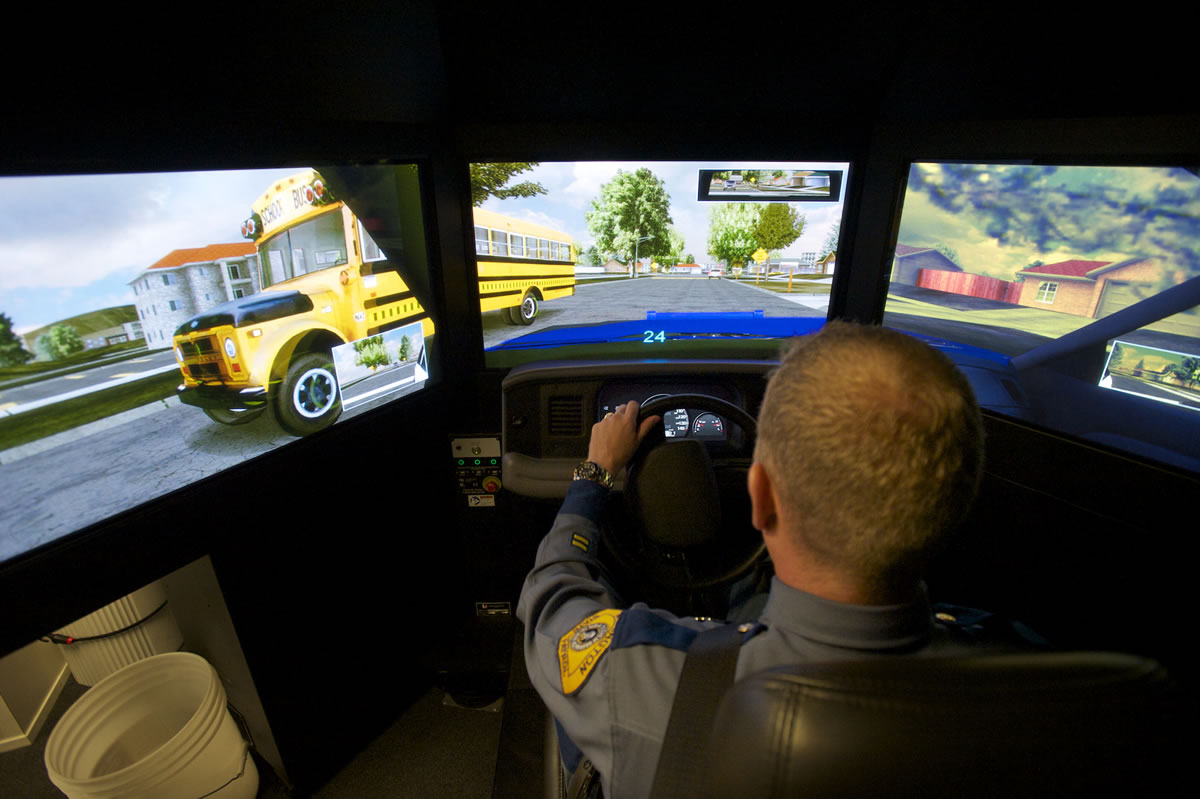It has three screens, a steering wheel, gas and brake pedals and even a console with a switch to activate flashing lights and sirens.
Although it has all the makings of a video arcade game, the contraption is actually a training device — a driving simulation tool used by Washington State Patrol.
“The simulator itself is not going to teach (troopers) how to drive,” said Cpl. Mark Lewis, lead driving instructor. “It is training focused on judgment and decision-making.”
One by one this month, 76 troopers from the state patrol’s Southwest Washington region are filing into a trailer parked at the agency’s district office in Vancouver and getting behind the wheel of a virtual car.
Although they are only required to get driving training once every two years, troopers in Washington get trained once a year.
“We kill more officers behind a wheel from collisions than by knife, gun or other felonious activity,” Lewis said. “If they’re making mistakes in here,” he said, pointing to the simulator, “they’re likely making those same mistakes out there.”
The simulation training is used every other year, with troopers traveling to the agency’s academy in Shelton to drive actual patrol vehicles during the alternating years.
Lewis said there are benefits from each type of training.
For example, one of the benefits of the simulator is cost savings. While it came with an initial price tag of $110,000 in 2009, it ends up saving the agency hundreds of thousands of dollars in time and travel costs. The WSP spends $800,000 to $1 million annually to send all troopers to the academy in Shelton; trucking the simulator around the state to WSP offices costs much less.
“We also don’t have coverage issues,” Lewis added. He said troopers only take about an hour out of their day instead of the agency losing a trooper for an entire day of traveling and training.
The real training benefit, Lewis said, comes in the situations that otherwise would be impossible or costly to create in live training.
For example, driving instructors can exactly replicate a scenario to illustrate a point. And if a trooper makes a mistake, such as crashing, the animated training means there are no serious repercussions, Lewis said.
“You don’t wreck cars, nobody gets hurt and you can rewind,” he said. “Live, hands-on training is the best, but there are some things you can’t set up for safety reasons.”
Officers feel the G-force of the vehicle during the live trainings, which allows troopers a better chance to refresh their skills maneuvering the vehicle.
In the simulation training, troopers are taken through various scenarios, including providing backup to another officer and chasing a drunk driver. The simulation requires law enforcement to safely navigate roadways by making sure each lane is clear before going through a red light of an intersection and responding appropriately to unexpected situations.
“Detour — what are you going to do?” Lewis asked as he stood over Trooper Will Finn, sitting in the driver’s seat.
Reaching speeds of 70 mph on busy streets, Finn was able to safely handle the virtual car while passing school buses and getting by vehicles that didn’t yield to his emergency lights and sirens. He quickly made it to the intersection, where he met another officer that had an avatar felon in handcuffs on the ground.
“The decisions they make, even though it’s simulated, are the same type of decisions they would make in their car in a real-life situation,” Lewis said.




